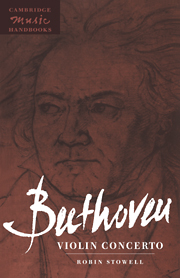Book contents
- Frontmatter
- Contents
- List of figures
- Preface
- 1 Towards the Violin Concerto Op. 61
- 2 The genesis of Op. 61
- 3 Reception and performance history
- 4 The textual history
- 5 Structure and style I – 1. Allegro ma non troppo
- 6 Structure and style II – 2/3. Larghetto – Rondo: Allegro
- 7 Cadenzas
- Appendix 1 Select discography
- Appendix 2 Published cadenzas
- Appendix 3 Textual problems perpetuated in some printed scores
- Notes
- Select bibliography
- Index
1 - Towards the Violin Concerto Op. 61
Published online by Cambridge University Press: 28 October 2009
- Frontmatter
- Contents
- List of figures
- Preface
- 1 Towards the Violin Concerto Op. 61
- 2 The genesis of Op. 61
- 3 Reception and performance history
- 4 The textual history
- 5 Structure and style I – 1. Allegro ma non troppo
- 6 Structure and style II – 2/3. Larghetto – Rondo: Allegro
- 7 Cadenzas
- Appendix 1 Select discography
- Appendix 2 Published cadenzas
- Appendix 3 Textual problems perpetuated in some printed scores
- Notes
- Select bibliography
- Index
Summary
Beethoven's Violin Concerto in the context of his oeuvre
Beethoven began to make his mark as a composer during the 1790s. Apart from one visit to Vienna in 1787, when he met and impressed Mozart, family problems had virtually tied him to Bonn. In late 1792 he returned to Vienna, this time to stay. His ascendancy was rapid. His entry into Viennese social circles was eased by support gained from the Elector-Archbishop Maximilian Franz of Cologne, uncle of the Emperor Leopold II, and Count Waldstein. So, too, was his acceptance as a pupil of Joseph Haydn from late 1792 to 1793. More influential, however, were his studies in counterpoint with Albrechtsberger and his occasional instruction from the Imperial Kapellmeister Antonio Salieri. By the turn of the century his compositions had gained for him such prestige that he could write to Franz Wegeler, ‘I am offered more commissions than it is possible for me to carry out…people no longer come to an arrangement with me, I state my price and they pay.’
It has long been customary to divide Beethoven's oeuvre into three periods on the basis of style and chronology. Maynard Solomon, among others, has recently subjected this doctrine to close and sceptical scrutiny but has concluded that these periods are reinforced by many historical and stylistic factors, especially the significant changes in Beethoven's inner life, in his fundamental modes of patronage, and indeed in the Viennese Zeitgeist at large.
- Type
- Chapter
- Information
- Beethoven: Violin Concerto , pp. 1 - 10Publisher: Cambridge University PressPrint publication year: 1998



